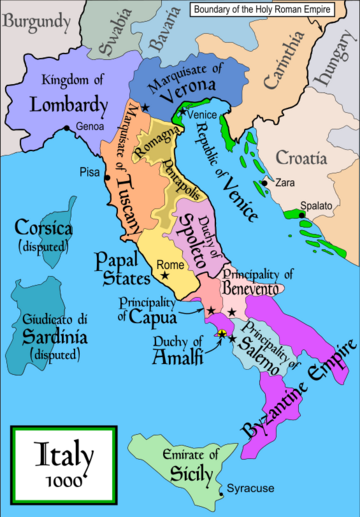Italian city-states facts for kids
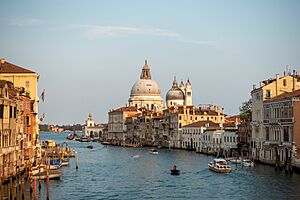
The Italian city-states were like small, independent countries that existed in the Italian Peninsula for a very long time. They started in ancient times and lasted until Italy became one united country in the late 1800s.
In ancient times, there were city-states built by the Etruscans, Latins (like Rome), and Greeks (Magna Graecia). After the fall of the Western Roman Empire, many cities in Italy kept going strong, unlike other places in western Europe. These cities were often built on older Roman, Etruscan, or Umbrian towns. The idea of a republic, where people had a say in their government, also lived on from Roman times.
By the 11th century, many cities like Venice, Milan, Florence, Genoa, and Pisa grew into big trading centers. They became powerful enough to gain independence from the rulers who formally controlled them. Some of these cities became very important, turning into duchies (areas ruled by a duke) or maritime republics (trading empires based on sea power).
Contents
Ancient Italian City-States
The cities of Magna Graecia (ancient Greek settlements in southern Italy) and Etruria (where the Etruscans lived) were some of the first city-states in Italy. Rome, a Latin settlement, also started as a city-state in 753 BC. Rome later created many new towns and cities across Italy. This network of Roman cities survived even after the Western Roman Empire fell. This helped new city-states appear again in the Middle Ages.
City-States in the Middle Ages
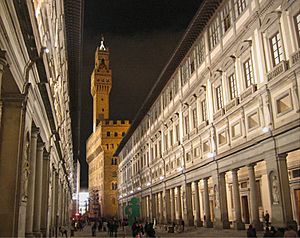
Some of the first city-states in medieval Italy began to form as early as the 7th century. These included the Duchy of Naples, Duchy of Amalfi, Gaeta, and the Republic of Venice. Even though they were technically under Byzantine control, they acted as independent states. Other areas, like the Duchy of Spoleto and the Duchy of Benevento, were controlled by the Lombards.
The Communes: Cities Gaining Freedom
Many other early Italian city-states in northern and central Italy grew because they fought for more freedom from the Holy Roman Empire. The Lombard League was a group of cities in northern Italy that joined together. This league included major cities like Milan, Piacenza, Cremona, Mantua, Bergamo, Brescia, Bologna, Padua, Verona, and Parma.
Other important city-states, known as "communes," were also part of this movement. These included Genoa, Turin, and in central Italy, cities like Florence, Pisa, Lucca, Siena, Ancona, and Perugia.
Maritime Republics: Masters of the Sea
Amalfi, Gaeta, and Venice were already independent maritime republics by the 11th century. Around the year 1100, Genoa, Pisa, and Ancona also became independent maritime republics. They became very strong because of their trade, shipbuilding, and banking. These activities helped them build powerful navies that controlled the Mediterranean Sea during the Middle Ages.
| Republic's name | Capital city | Years of Rule |
|---|---|---|
| Republic of Venice | Venice | 697–1797 |
| Republic of Gaeta | Gaeta | 839–1140 |
| Republic of Amalfi | Amalfi | 958–1137 |
| Republic of Pisa | Pisa | 1000–1406 |
| Republic of Genoa | Genoa | 1000–1797 |
| Republic of Ancona | Ancona | 1000–1532 |
| Republic of Noli | Noli | 1192–1797 |
| Republic of Ragusa | Ragusa | 1358–1808 |
Why Italy Was Different
Between the 12th and 13th centuries, Italy was very different from the rest of Europe north of the Alps. Italy was a mix of many different political and cultural areas, not one unified country.
Italy's many mountains made it hard for cities to communicate with each other. The Po plain was an exception, as it was a large flat area. Most city-states that were conquered were located there. The cities that lasted the longest were in tougher regions, like Florence, or Venice, which was protected by its lagoon.
The rugged Alps also stopped the Holy Roman Emperors and German princes from easily attacking northern Italy. This helped keep Italy safe from long-term German control. Because of these reasons, strong kingdoms like those in other parts of Europe did not appear in Italy. Instead, independent city-states grew.
During this time, Italy saw many changes from the 11th to the 13th centuries:
- The population grew a lot, almost doubling.
- Huge cities appeared. Venice, Florence, and Milan each had over 100,000 people by the 13th century. Other cities like Genoa, Bologna, and Verona had over 50,000 people.
- Many people moved from the countryside to the cities. About 20% of Italy's population lived in cities, making it the most urbanized (city-living) society in the world at that time.
- Farming methods improved.
- Trade grew rapidly.
Money and Trade
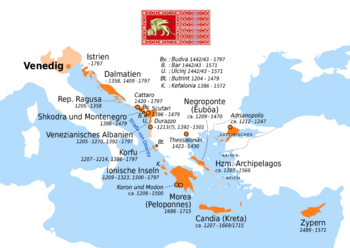
It is thought that the average income in northern Italy almost tripled from the 11th to the 15th century. This was a time of great movement and growth, driven by fast-growing trade.
In the 14th century, as the Italian Renaissance was beginning, Italy was the economic capital of Western Europe. Italian states were the main producers of finished wool products. However, with the Bubonic Plague in 1348, the rise of the English wool industry, and ongoing wars, Italy temporarily lost its economic lead.
By the late 15th century, Italy was again in control of trade across the Mediterranean Sea. It found a new market in luxury items like ceramics, glassware, lace, and silk. The wool industry also saw a temporary comeback.
Italy never fully regained its strong position in textiles. Even though banking started in Italy, German and Dutch banks began to take over the business by the 16th century. The discovery of the Americas and new trade routes to Africa and India by the Portuguese shifted economic power. Portugal became the leading trading power in the 16th century, followed by the Netherlands in the 17th century, and the United Kingdom in the 18th century.
Reading and Math Skills
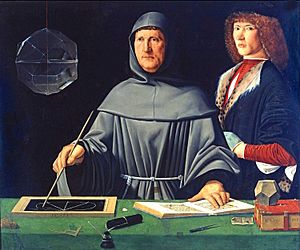
By the 13th century, northern and central Italy had the most people who could read in the world. More than one-third of men could read in their everyday language. A small but important number of women could also read.
Italian city-states were also very good at math. This was important because of new ways of bookkeeping that were key to their trading society. Some popular books, like Liber Abaci by Leonardo Fibonacci of Pisa, showed how to use math and arithmetic in business.
Indeed, Luca Pacioli helped create the banking system of the Italian city-states with double-entry bookkeeping. His 27-page writing on bookkeeping was the first known published work on the topic. It is said to have set the foundation for how double-entry bookkeeping is done today.
How Communes Became Powerful
During the 11th century in northern Italy, a new political and social system appeared: the city-state, also called a medieval commune. The way people lived and thought in these cities was quite special. In some places, like Britain and France, communes were later taken over by kings. But in northern and central Italy, they stayed independent and powerful city-states.
Italian cities broke away from their feudal lords (powerful landowners) in the late 12th and 13th centuries. This happened during the Investiture Controversy, a big fight between the Pope and the Holy Roman Emperor. Milan led the cities of Lombardy against the Holy Roman Emperors and defeated them. This led to them gaining independence in battles like the battle of Legnano in 1176 and battle of Parma in 1248.
Some Italian city-states became strong military powers very early on. Venice and Genoa built huge naval empires in the Mediterranean and Black Seas. Some of these empires even challenged the growing Ottoman Empire. During the Fourth Crusade in 1204, Venice conquered a large part of the Byzantine Empire.
The Maritime Republics were a key result of this new city culture, which was based on trade and sharing knowledge with other parts of the world. For example, the Republic of Venice and the Republic of Genoa had important trade connections with the Muslim and Byzantine worlds. This helped kickstart the Italian Renaissance.
By the late 12th century, a new and remarkable society had formed in Northern Italy. It was rich, growing, and had a mix of noble families and wealthy city dwellers (called borghese). These groups were interested in city institutions and republican government. However, many of these new city-states also had violent groups based on families or brotherhoods, which sometimes caused problems within the cities (for example, the Guelphs and Ghibellines).
Princely States and Regional Powers

By 1300, most of these republics had become "princely states." This meant they were controlled by a single powerful ruler, called a Signore. The exceptions were the Republics of Venice, Florence, Genoa, and Lucca, which managed to stay republics even as Europe became more monarchic (ruled by kings). In many cases, by 1400, these Signori were able to create a stable family rule over their cities. They often bought noble titles from their formal superiors. For example, in 1395, Gian Galeazzo Visconti bought the title of Duke of Milan from King Wenceslaus for 100,000 gold florins.
In the 14th and 15th centuries, Milan, Venice, and Florence grew even larger. They conquered other city-states and created bigger regional states. The Peace of Lodi in 1454 ended their fight for control in Italy. This agreement helped create a balance of power among the states, which was important for the Italian Renaissance.
By the early 16th century, only the Republic of Venice, along with a few smaller city-states like Genoa, Lucca, and San Marino, was able to stay independent. Venice was strong enough to stand against the big European kingdoms of France and Spain, and the Ottoman Empire during the Italian Wars.
See also
 In Spanish: Ciudades-estado italianas para niños
In Spanish: Ciudades-estado italianas para niños
- History of Italy
- Medieval commune
- Repubbliche Marinare
- Guelphs and Ghibellines
- Italian Renaissance
- San Marino
- Vatican City
- List of historic states of Italy



